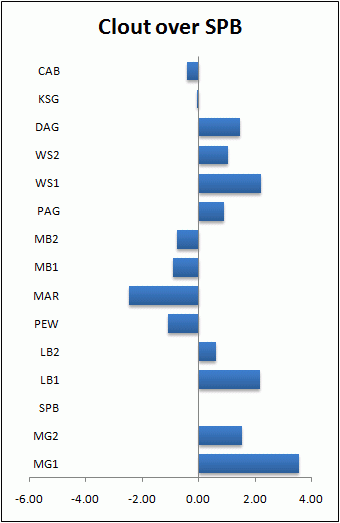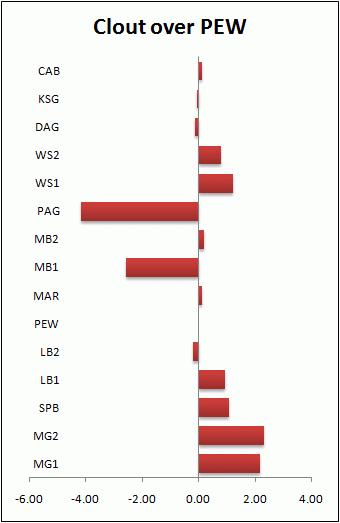The idea of "clout" and "vulnerability" of a product in a pair with
another one was introduced by Anderson
and Willey and Lazari
and Anderson as an application of psychometric methods in
marketing. It is also known as "availability" or "cross-effects"
model. Utility of a product is understood as differing in presence or
absence of another product in the choice set. In analogy to similar
problems in psychometry, the conflict is reconciled by adding parameters
that absorb the influences of the competing products in the choice set,
with the parameters estimated as first-order (pair-wise) interactions.
A study of cross effects between products leads to a substantial increase
in number of parameters that must be estimated. For N products the
additional number of pairwise cross effects is ((N-1)N/2). In a realistic
case of 26 products we would have additional 325 parameters. Such a number
would lead to an inestimable, heavily oversaturated system, for an
individual. Therefore, originally aggregated approach had been suggested.
With Bayes hierarchical
estimation methods, an individual approach is possible under certain
conditions. The conditions can be achieved by introducing reasonable
restrictions in the model such as excluding some of the cross effects from
estimation. This is possible for products with negligible shares, little
interest in, or those that are known as non-interacting with other
products.
Estimation of cross effects is expected to be useful in CPC/FMCG product categories where personal tastes play a dominant role. In our experience, the fit between estimated and observed choices is increased not only "visibly" but also based on Bayes or Akaike information criterion, i.e. taking into account the increased number of estimated parameters. The cross-effects model seems to pin-point the current or potential direct competitors that main-effect based utilities cannot provide. It may be useful in cutting into the cannibalization problem. Another use is possible for study of inventory availability effects, outlet type selection, etc.
 As aside
As aside
The influence of a cross-effect on shares of the products involved in the
effect is highest when both products have the same main-effect utilities,
i.e. about the same shares. The higher the difference in utilities the
lower the cross-effect is.
The typical outputs from the method are preference share simulations with
different scenarios. A direct comparison of clout and vulnerability in
logit units for each of the product pairs of interest seems to be even
more illustrative since the cross-effects are often obscured by the main
effects that usually dominate. However, the direct comparison of
cross-effects requires that the sample or sub-sample is as homogeneous as
possible. LCA - Latent Class
Analysis may be used for finding such sub-samples.
A marked disadvantage of the method is size of the sample required to
estimate the large number of parameters. The minimum is about 400
respondents in a medium size project of about 20 brands.
 As aside
As aside
The objective of the study were price elasticities of cigarette brands
available on the local market. For purpose of CEA analysis, all prices
have been set at their market values. Clouts of the tested brands in
respect to two selected domestic brands, SPB and PEW, are shown below.


[ Note: If you do not see the pictures above side by side please make the browser window wider. ]
Cross-effect profiles of the two domestic brands were clearly different.
The only common property was that both were loosing against imported brand
variants MG1 and MG2. Utility of brand PAG as an isolated (stand-alone)
product was about 1 logit lower than that of brand PEW. In presence of the
latter, the former one looses another 4 logit units and becomes virtually
unmarketable.